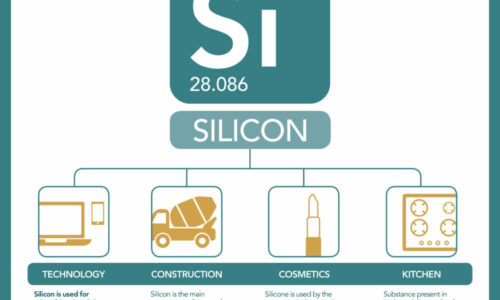2019 has been chosen by the United Nations General Assembly as the International Year of the Periodic Table. This year we celebrate the 150th anniversary of the creation of the renowned table, formulated by Russian chemist Dmitri Mendeleev who, in 1869, arranged the then-known elements according to their increasing atomic mass. With this first post about silicon, Barcelonesa begins a series of monthly publications dedicated to chemical elements that are essential to the industry.
Silicon, whose symbol on the periodic table of elements is ‘Si’, is the second most abundant element in the Earth’s crust after oxygen. Also abundant are its multiple uses, for example in the technology sector. The famed ‘Silicon Valley’, a region near San Francisco in the United States, owes its name to the large number of technology and electronics companies headquartered there. These companies use silicon for their microchips since it is an ideal electricity conductor. “Without silicon, we wouldn’t have computers or mobile phones”, states Juan Carlos Montoro, director of the Industrial Business Unit. Nor would we have 90% of the solar panel cells, which are revolutionising the current energy outlook1.
“Its properties, which are similar to carbon, make it an element that is very complicated to replace”, explains Montoro. “So many products depend on this element, not just in the industry, but in people’s day-to-day lives as well”, the expert adds. Construction, for example, is another large industry that would be greatly affected if silicon didn’t exist, and not without reason, since it is the main component in glass, cement, or ceramic. Silicon is also the main component in the sand that is used to manufacture bricks, mortar, concrete, and cement. The Barcelonesa expert also highlights that without it, “our buildings would be much more damp since it’s an excellent element for sealing and absorbing moisture”.
Silicon is also the main component in silicone, a material used in a wide range of products thanks to its resistance to extreme temperatures, its insulation capacity, its resistance to deformation, and the fact that it is suitable for food and sanitary use. All in all, its excellent versatility makes it one of the most valuable materials for any industrial sector.
Silicone is used in the cosmetic industry in the manufacture of hairspray, lipstick, sunscreen, and moisturising creams. The pharmaceutical industry is another large consumer of silicone, due to its low reactivity. It is estimated that over 1,000 medical products contain silicone, such as prosthetic valves, catheters, and breast implants, for example. It is also a commonly used substance in paints, as well as having a significant presence in kitchens, given that it’s an odourless polymer that is heat resistant and has non-stick properties. This means it can be used in a wide variety of products that come into contact with foodstuffs.
In conclusion, technology and electronics, the construction industry, pharmaceuticals, cosmetics, or even the food industry wouldn’t be what they are without silicon.


